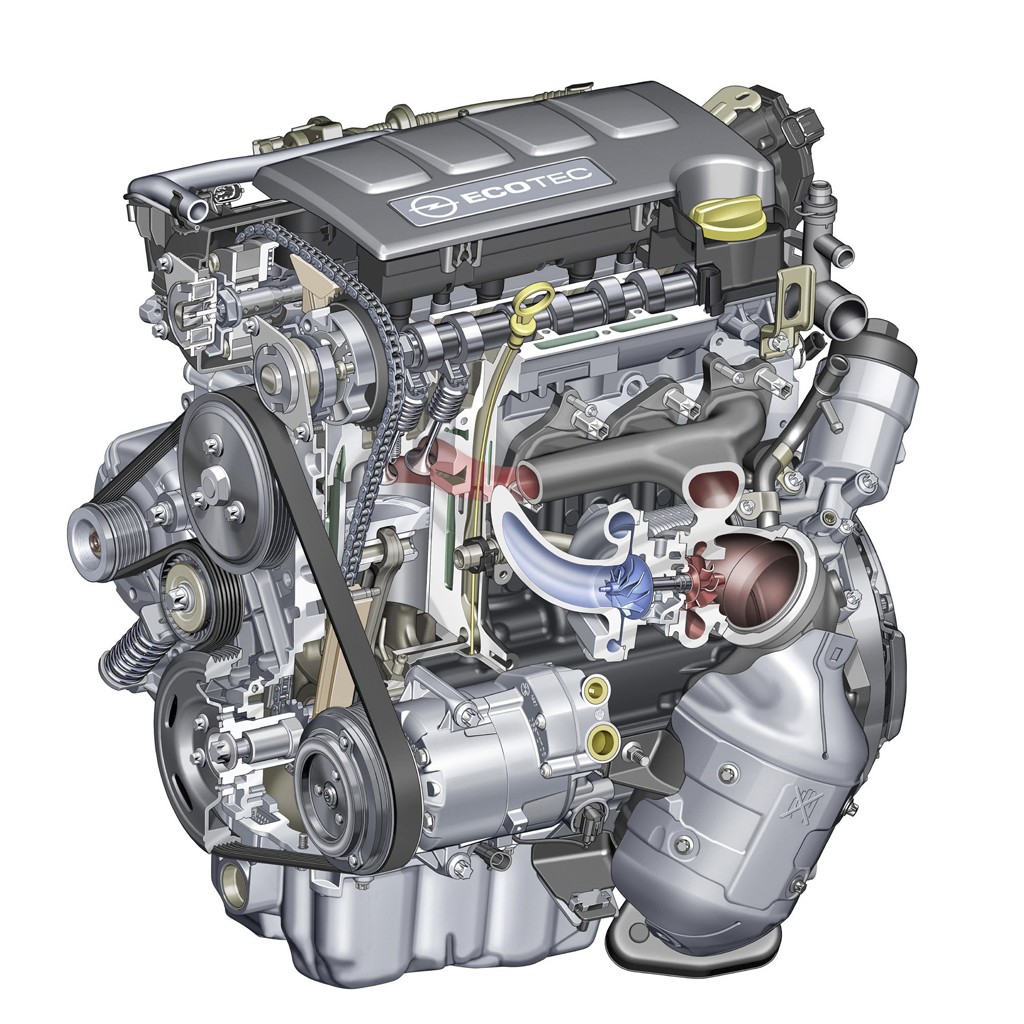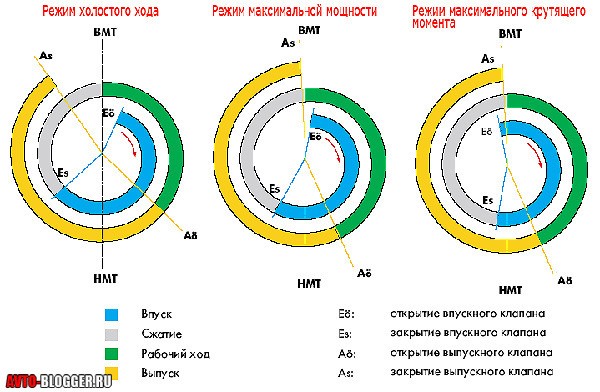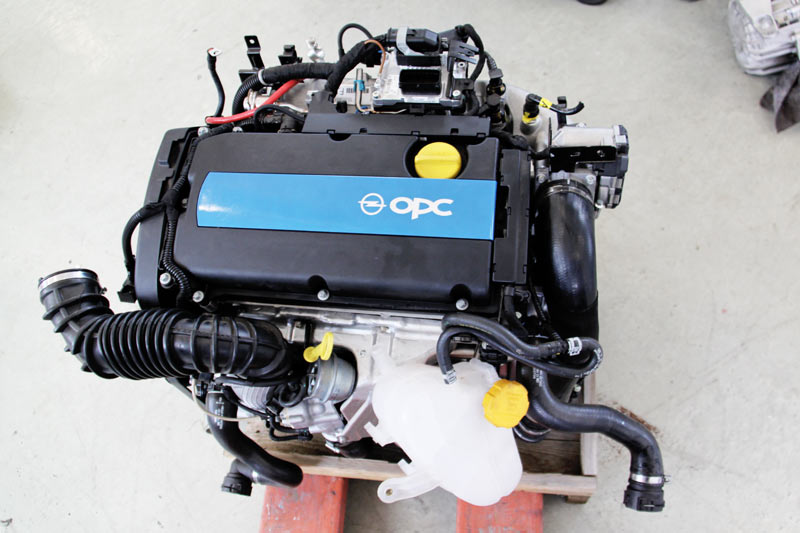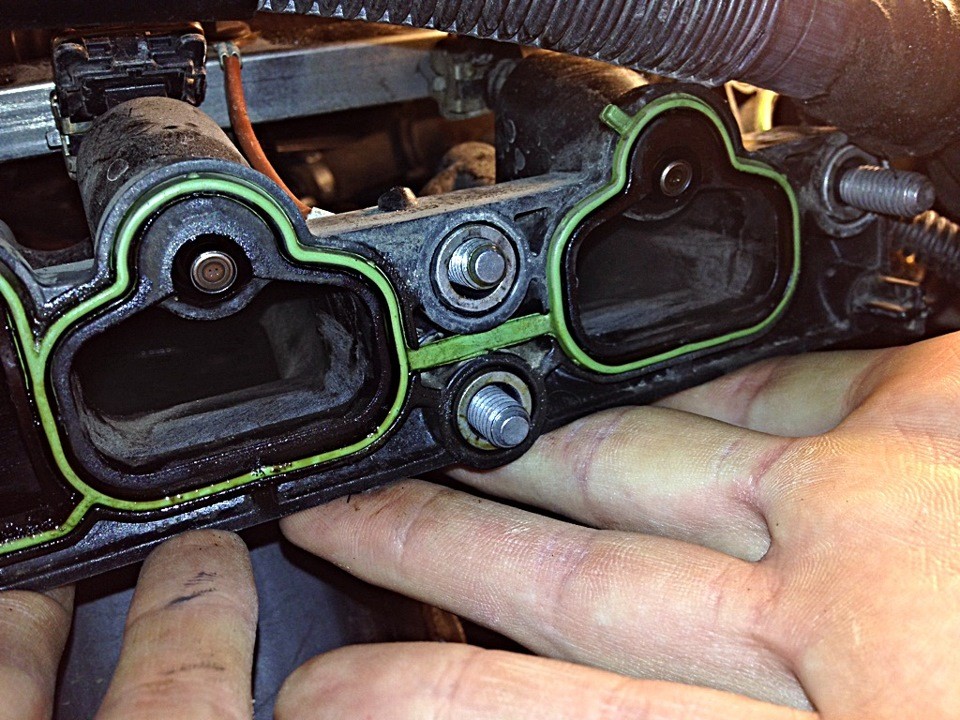
Chevrolet A14NET engine
A new A14NET engine appeared in 2010. The main feature of the motor is the combination of a turbine with a small-capacity power plant. Chevrolet Cruze and Opel models were equipped with such a unit - they consume 5,2 liters per 100 kilometers on the highway. The 1.4 liter engine has a capacity of 143 hp. With.
Description

Experts call it a reliable engine, modern and economical, with a number of technical innovations.
- Improved engine performance, implemented through the use of modern injection.
- The ACCS system installed on Chevrolet and Opel completely eliminates the failure of speed during acceleration and maneuvers.
- The ACCS system also helps to reduce fuel consumption on highways and in the city.
- There are phase shifters on both shafts, which increases the filling of the chamber with an air-fuel mixture.
- The engine uses a small turbine, inflating 0,5 bar almost from a standstill. Thanks to its work, the thrust of the power unit is stabilized, power is increased, and fuel consumption is reduced.
- If the A14NET engine is fully electronically controlled, the sensors used monitor the characteristics and capabilities of the unit in real time.
- Timing drive on A14NET - chain. It significantly increases the reliability of the gas distribution mechanism. The metal chain does not break as often as a rubber belt, thereby eliminating the risk of damaging the valves.
- The motor uses hydraulic lifters, which eliminates the obligation to adjust the valves every time.
| A16LET / LEL / LER | A14NET / NEL | |
|---|---|---|
| Winemaking | Plant Szentgotthard | Opel plant aspern |
| Cylinder block material | Cast iron | Cast iron |
| Supply system | Injector | Injector |
| Type | Inline | Inline |
| Number of cylinders and valves | 4 4 | 4 4 |
| Piston stroke | 81,5 mm | 82,6 mm |
| Bore | 79 mm | 72,5 mm |
| Compression ratio | 8.8 | 9.5 |
| Engine capacity | 1598 cc | 1364 cc |
| Engine power | 180(150, 192) hp /5500 (5000, 5850) rpm | 143 (120) hp /4900-6000 rpm |
| Torque | 230 (210, 230) Nm / 2200-5400 rpm | 200 (175) Nm / 1850-4900 (1850-4200) rpm |
| Fuel | 95 | 95 |
| Environmental standards | Euro 5 | Euro 5 |
| Fuel consumption | city 9,9 l. | track 5,6 l. | mixed 7,2 l/100 km | city 8,1 l. | track 5,2 l. | mixed 6,2 l/100 km |
| Oil consumption | up to 0,6 l / 1000 km | up to 0,6 l / 1000 km |
| What kind of oil to pour | 5W-30 | 5W-30 |
| How much oil is in the engine | 4,5 l | 4 l |
| Oil change is carried out | every 15000 km | every 10000 km |
| resource in practice | 200-250 thousand km | 350 thousand km |
| Chip tuning potential | 230 l. With. or 200 l. With. (no loss of resource) | 180-190 h.p. |
| Engine installed | Chevrolet Cruze, Opel Meriva V, Opel Insignia, Opel Astra, Opel Corsa | Chevrolet Cruze, Opel Mokka, Opel Meriva V, Opel Insignia, Opel Astra, Opel Corsa |

Disadvantages of the engine
However, the engine is clearly not suitable for fans of fast, aggressive driving. Rather, this is the lot of motorists who prefer a calm rhythm of movement with periodic accelerations. The new engine also has shortcomings that the engineers could not eliminate.
- The motor is seriously loaded due to high returns - pistons can easily crumble.
- It is overly sensitive to the quality of the lubricant - only official oil should be poured. The lubricant must be replaced at least once every 10 km.
- The environmental standards of the engine comply with Euro-5. Obviously, pouring low-octane gasoline into the engine will be more expensive for itself - only 95 and above.

During the operation of the engine, the following shortcomings were also identified.
- After some time, regardless of the vehicle's mileage, oil leaks through the cylinder head cover.
- The motor begins to make noise, reminiscent of the operation of a diesel engine - a classic "disease" of Opel engines with phase regulators.
- The water pump fails, starts to whistle, which necessarily requires a visit to the service station, otherwise there is a risk of engine damage.
- The A/C compressor bearing makes a screeching noise for no apparent reason.
- Another typical disease of A14NET is considered to be clicking sounds. This is how injectors work.
- The engine likes to vibrate for no reason, this is normal.
The screeching sounds of the air conditioning compressor and vibrations, the destruction of pistons, increased oil consumption, detonation are the first signs of an approaching capital.
Crankshaft oil seal
An increase in fuel consumption (up to 12-12,5 liters), floating idle speeds, as well as a characteristic engine whistle (distinguished on the twentieth) are a familiar situation for Chevrolet Cruze owners. During the increase in speed, the noise is almost inaudible, but it can turn into a metallic rattle. Interestingly, this situation occurs on cars with low mileage.

The problem with the front crankshaft oil seal - experienced mechanics will diagnose. The seal is either too tight, or worn out, and air escapes through it when the temperature rises, creating noise. However, not all masters are able to give a correct assessment, and often this symptom is confused with a malfunction of the overrunning generator clutch. If there is no original replacement part, then owners are advised to drive a little more. Imagine the surprise when, after the generator has been rebuilt, the noise does not disappear.
It is enough to replace the oil seal, as everything is back to normal. Noise will disappear, speed will stabilize, fuel consumption will decrease.
If you follow the manufacturer's recommendations, do not abuse low-grade gasoline and oil, the A14NET engine will easily run 350 thousand kilometers without major intervention and major repairs.
Modifications
The following versions of this engine are known.
- A14NEL is a derated version that was released in 2012. It was installed for the first time on the Opel Astra and some cars of the General Motors concern.
- A16LET with a working volume of 1.6 liters, a capacity of 180 liters. With. This is a complete copy of the A14NET, but with a larger piston diameter. It is also economical, reliable and durable.
- A16LER is a sports version that develops 192 hp. With. It differs from its predecessor by an improved intake system and new firmware.
- A16LEL is an upgraded version that develops 150 horsepower. It is put on various cars, including Opel Corsa.
A14NEL appeared in 2012. Since then, it has been installed on Chevrolet, Opel Astra and other models of the manufacturer General Motors. In general, this is the same A14NET, with hydraulic compensators, a GDS phase change system, and a small turbine.
A16LET introduced in early 2006 on the Opel Meriva car. The main feature of the engine is an amazing specific power that does not fit in with the working volume - the 1.6 liter version produces 180 hp. With. The engine is equipped with a GDS phase change system on both shafts, a KKK K03 turbine, which is easily inflated already from 2200 rpm. No turbo lags, unstable thrust on almost the entire range.
The main difference between the A16LET and its predecessor Z16LET is the European eco-standard. The new engine uses Euro-5, the old one uses Euro-4.

Typical malfunctions of the A16LET are similar to the "sores" of the A14NET. Grease leaks from under the cylinder head cover can be eliminated by periodically updating the gasket and tightening the bolts securely.
Modernization
If modernization is not welcome in relation to atmospheric power plants, in the case of the A14NET, experiments will only benefit. The potential of the engine allows this, and specialists have ready-made programs. For example, the catalyst is removed, which ultimately leads to the issuance of an additional 20 hp by the engine. With.
Refining the intake system is also a common type of A14NET tuning. We are talking about partitions installed on new collectors. They cover at least 30% of the space, limiting the capabilities of the engine. Many tuners, when chipping this engine, are dissatisfied with the result. It turns out that the whole thing is precisely in the intake manifold, requiring alteration.
So, the modernization of the collector begins with the dismantling of all interfering components, including connectors and so on. After unscrewing the bolts, you can get to the harmful partitions. They should be carefully cut out, then aligned, put everything back together. This will be enough - the owner of the car will immediately feel the smooth running of the car, a clear gear change, improved traction from the bottom. And if you also carry out chipovka, the engine will reveal its full potential.

| computer intelligence | Who bought with dviglom 1.4 NET? Please write back, does the engine warm up for a long time, does the stove warm up the interior well? Just already thinking about what to take 1.4 or 1.8 like 1.8 in 6-mortar mechanics, but alas. If I don’t freeze in the cabin with 1.4 NET and cut circles around the car for a long time for joint warming up, then I can turn my face to 1.4 NET. What is alarming in 1.4 NET (perhaps there are rumors): 1) Capriciousness in food (does not like body gasoline very much), but in distant lands you can run into a bodyagi with the AI-95 label and nothing can be done about it; 2) The presence of a turbine, which increases the cost of car maintenance (after 80 km of run); 000) A small volume gives less acceleration at the start than even aspirated, but 3 (possibly when you press the gas pedal (not on the machine, i.e. a car without a kickdown), the turbine turns on immediately and the engine gives out already at the start up to a maximum of 1.8 hp. With. |
| teip | and put Webasto, Eberspacher or heatstar who interferes? |
| you love | The engine is pretty good, but if you want to ride it for a long time, then fill ONLY 95 and at proven gas stations, and not shukhra-mukhra. He confirmed the fears that the engine warms up much longer than 1.8, but when driving it quickly reaches the optimum temperature regime (maybe the manager drives it). About the 6-mortar, I assured that this is not a 5-mortar with compressed gears, but in general a new box with its gear ratios, by the way, I saw it in the cabin, it looks very different from the 5-mortar. The radiator and air conditioner fan is one and the same. That is, who has climate control in the heat of more than 35 degrees, it is better to switch from climate to condo, i.e. turn off the AUTO mode, a new (it is cunning) fan costs around 250 - 300 euros. But closer to the summer we will arrange a lekbez on the forum. |
| Newcomer | The turbine gives 200 Nm from the minimum speed, the maximum 140 horsepower is available at 3.500 rpm. Therefore, Mokka 1.4 will be noticeably faster and more economical than its atmospheric companion |
| a lion | My wife and I have an Astra 1,4 turbo. It warms up at -35 well, put an auto-heater and threw an auto-heat under the hood (a special one that does not burn - the cost is 1200 rubles) - the result is warm in the cabin, heats up quickly and cools down slowly. As for gasoline, in general, the first year they poured 92 and drove calmly, then we decided to pour 95 just in case, we have been driving for a little over a year, barely noticeable but faster than 92))) Now we are licking our lips at Mocha, but we are waiting for the machine to go with turbine. 1,8 is still not so smart |
| Fedot is not the same | I agree with my colleague on Astra. if without a piece of cardboard and a blanket, then it will take a long time to warm up, and it will cool down when parked, well, if this is a strong minus. I go without a blanket and a cardboard box, because the parking is warm) gasoline 92 is generally contraindicated for turbines, I myself pour 95G from a jeep. the downside of the engine in your case may be a loss of power when the conder is on, if the car is still full, then the engine must be cool to turn. The box is really good, there is nothing to add here. |
| Beck | yesterday I talked with the manager about installing a turbo timer and he assured me that a turbo timer is not needed for this engine because the turbine has its own lubrication system, unlike engines of earlier production, in which the turbine shafts were lubricated from the engine oil pump. from this follows the question of how and with what it is lubricated the manager did not answer I want to find answers since the topic is serious because the turbine is a stumbling block when choosing an engine |
| Syoma | this engine can be used without a turbo timer, but at the same time you need to follow a simple rule (it is written in the operating book): if you strongly strained the turbine before “switching off” the engine, then you need to let it idle for about a minute after stopping, but if you In a quiet mode, you drive up to the parking lot, you can immediately turn off (basically, this happens until you drive into the yard, parking, parking just at low levels and drive in). So it goes |

